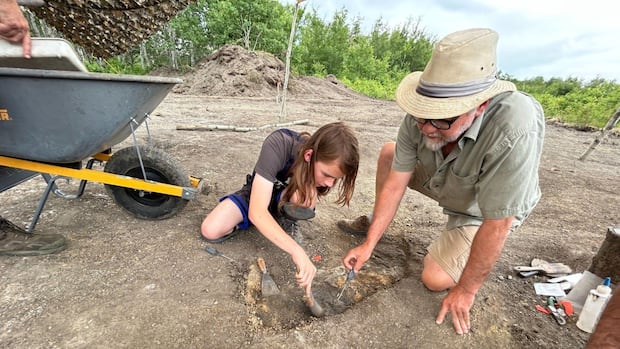As Canada’s reliance on U.S. produce hits the spotlight, one Ontario farmer has a pitch: locally grown, year-round produce, grown by artificial intelligence and automation.
In a sprawling two-hectare greenhouse, tucked inside a wooden red barn in King City, Ont., an animated Jay Willmot, farmer and entrepreneur, shared his vision.
“From sowing and seeding, all the way through to harvest and packing, no one touches this crop,” he said in front of rows and rows of lettuce shoots.
Instead, multimillion-dollar AI and machinery does the work; the whirring and clicking of conveyor belts, hooks and levers, fills the space that was once part of his family’s horse farm.
Willmot built his business, Haven Greens, to tackle the Canadian winter and a laundry list of obstacles that farmers face — from high labour costs to unpredictable weather. He’s not alone; federal and provincial governments have offered incentives to encourage automation.
Some experts do urge caution though — saying widespread adoption could have unintended consequences.
Lettuce close to home
Even without AI, a traditional greenhouse, or a vertical farm, would have addressed the issue of year-round growth. It’s a route many are choosing to take; Canadian greenhouse lettuce production alone has quadrupled over the last decade, according to Statistics Canada.
Willmot said automation and artificial intelligence allows him to maximize the amount of lettuce he can grow, while cutting labour costs, typically a greenhouse grower’s biggest operating expense.
The company also uses solar power, rainwater and other “energy-efficient systems” to keep costs down, he said. And he says the AI cuts out a lot of the waste that comes with guesswork.
A King City, Ont., greenhouse, Haven Greens, is harvesting thousands of kilograms of lettuce daily, all grown with automation and AI. The grower hopes it’s a model that will catch on but experts say the technology is still in its opening act, and deserves closer scrutiny.
“We have sensors that measure temperature, light intensity, humidity levels, and pressure levels. Everything within this greenhouse is automated by that central computer to achieve optimal growth conditions.” he added.
The company says the greenhouse produces more than 4,000 kilograms of lettuce per day. It’s being sold through the Ontario food terminal and directly to a number of independent grocery stores.
For Willmot, the goal is a reliable product that doesn’t need to travel across a continent to hit store shelves.
“I was sick and tired of old, slimy, smelly lettuce,” he said. When California, where most of Ontario’s lettuce comes from, was hit by drought and disease in 2022, lettuce prices hit a record high.

“We need this all across the country so that we can build these local food systems that have inherent food sovereignty within them, that fight food insecurity, that can feed our local communities,” he argued.
Even with the “tens of millions of dollars” in start-up costs for the custom machinery and AI tech, Willmot calculates he can turn a profit on this model, while keeping the retail price “competitive.”
Less reliance on farm labour
It’s a business case provincial and federal governments are counting on.
Even before trade tensions pushed Canada’s dependence on U.S. produce back into the spotlight, there was a push to incentivize agricultural technology, to make Canada more self-sufficient.
In Ontario, for example, the government dished out $547,720 in 2021 to Great Lakes Greenhouses Inc, an operation in the heart of Leamington, Ont. — dubbed North America’s greenhouse capital for having the highest density of greenhouses on the continent. The cash was to help the company pilot an artificial intelligence system that would “allow greenhouse operators to remotely grow cucumbers and eggplant crops, reducing in-person contact,” a provincial press release reads.
B.C. also has an On-Farm Technology Adoption Program, offering cost-sharing funding for labour-saving tech like autonomous weeders, harvesters and sorters.
The country is heavily reliant on temporary foreign workers for farm labour. Nearly half of the people working in Canada’s agriculture sector were employed on a seasonal basis in 2022, according to Statistics Canada. It is a gap that Willmot believes automation can fill.

But Canada’s Research Chair in Science and Society, Kelly Bronson says, the impact on migrant workers need to be considered carefully.
“There’s all sorts of ethical issues presented by that labour supply solution in that these workers tend to be very precariously paid, precariously employed in terms of having no legal infrastructure to support them,” said Bronson, who has done research consulting migrant farmers.
“Many of them really depend on this income. We have to think about the consequences of displacing already the most marginalized actors.”
Willmot, however, believes Canada’s reliance on foreign workers is part of the problem.
“For us, we really like supporting people that are here,” he said. “I’ll take giving local people that live in our own backyard good-paying jobs 10 out 10 times.” The company says it has hired 35 full-time staff.

A call for a closer look
Bronson, who has specifically studied the growth and impact of agricultural technology, acknowledges the excitement around food sovereignty amidst a “geopolitical tariff warfare.”
But she urges caution — even with the company’s solar PV’s, rainwater usage, recaptured emissions, and wider net-zero promise.
“If you think about the energy costs of sustaining an indoor farming environment, they’re pretty huge. And even if you take a fuller view of AI, we know now the environmental costs in terms of data storage, the energy costs, the impact on climate in terms of data, storage facilities.”
She calls for detailed, independent research into the use and impact of the automation and AI model in Canada’s food systems, to test the claims its proponents make.
Cambridge University researchers have also warned about potential risks from rapid deployment of AI in agriculture, in a 2022 Nature Machine Intelligence paper, including accidental failure and unintended consequences.
“I think it is the future,” said Rozita Dara, director of the Artificial Intelligence for Food initiative at the University of Guelph. But she too urges the sector, and governments, to think about who can benefit from this often costly, technology.
“We have to keep smaller businesses in mind because we want them to operate and thrive in this situation.”

Back in King City, Willmot is confident in his vision. The third-generation farmer, and lawyer, is keenly aware that Canada’s farmers are aging out, and the new generation isn’t keen to take up the mantle. By 2033, 40 per cent of Canadian farm operators are expected to retire, and Statistics Canada numbers find that 66 per cent don’t have a succession plan.
We want “to show young people there’s exciting stuff happening in agriculture. And we need more people to come in and grow food for Canada,” he pitched.









